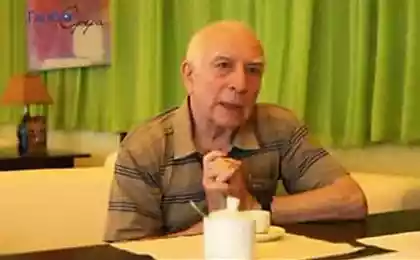524
Physics, with which you face daily
Appeared in the sale book Louis Bloomfield's "How everything works. The laws of physics in our lives". Tell about why it is worth reading — especially if physics is presented to you something boring and incomprehensible.
Getting up in the morning with a spring mattress, including electric kettle, warming his hands on a Cup of coffee and performing dozens of everyday things that we rarely think about how it all happens. Perhaps in someone's memory single shard sticking out Ohm's law or rule of thumb (well, if you do remember, "gimlet" is a screw, not a surname).

It is not always clear in what moments of life we meet with the current strength and momentum.
Of course, there are scientists, technicians and geeks. We are even willing to believe that there are people who are just very well taught physics at school (our them respect). For them will not be difficult to tell exactly how the incandescent light bulb or solar cell and explain, looking at a spinning Bicycle wheel, where there is static friction, and sliding friction. But let's be honest, most people have about all of this very vague idea.

Source: Pinterest
Because of this, it seems like natural objects and mechanisms behave in one way or another thanks to some magical powers. Household view on the causes and consequences can protect from some errors (for example, not to put foil wrapped foods in the microwave), but a deeper understanding of the physical and chemical processes allows you to better understand what was happening, and to argue their decisions.
Louis Bloomfield Professor of the University of Virginia, researcher, atomic physics, condensed matter physics and optics.
In his youth he chose experiences main research method in the world, drawing from the inspiration of the ordinary things for doing science. In an effort to make knowledge available to many people, not a handful of specialists in Bloomfield has been teaching, speaking on television and writing popular scientific works.
The main objective of the book "How everything works. The laws of physics in our lives" — to refute the idea of physics as dull and divorced from life science, and make it clear that it describes a real phenomenon that you can see, touch and feel.
For me it was always a mystery why physics is traditionally taught as an abstract science because it studies the physical world and the laws which he controlled. I'm convinced of the opposite: if you deprive physics of countless examples of living, the real world, it won't have any bases or forms is like a milkshake without the Cup.
Louis Bloomfield
We are talking about the motion of objects, mechanical devices, heat, and more. Instead of starting with theory, the author comes from the things around us, in formulating the laws and principles. The starting points serve as the carousel, roller coaster, water, warm clothes, audio players, lasers and LEDs, telescopes and microscopes...
Here are some examples from the book in which the author explains the mechanics of simple things.
Why skaters are moving fast
Skates is a convenient way to talk about the principles of the movement. Even Galileo Galilei has formulated that bodies tend to move uniformly in the absence of external forces, be it air resistance or surface friction. Skates can almost completely eliminate friction, so you slide on the ice. An object at rest tends to remain in place, and the moving object is to move on. It is called inertia.

Source: Pixabay
As cutting scissors
Shifting rings of scissors, you produce the moment of force under the action of which the blades closed and cut the paper. The paper seeks to push the blade through the moments of the forces, of "distributing" blade. If you put a big effort to "shift" the moment of force will prevail over "distributing". The result of the shear blades acquire an angular acceleration, starts to turn, grasp and cut a piece of paper.

Source: Pexels
What's going on in skewers
If you heat one end of a metal rod, the atoms in this part of the rod will oscillate more intensely than the cold end, and the metal will conduct the heat from the hot end to the cold. Some of this heat is transferred through the interaction of neighbouring atoms, however, the main part will be transferred to the mobile electrons that transfer heat energy over large distances from one atom to another.

Source: Рixabay
As the nails are hammered
All the downward momentum that you provide the hammer, swung, is transferred to the nail during the brief strike. Since the transmission time of the pulse is small, from the side of the hammer should be applied a very large force to the momentum transferred to the nail. This impact force drives the nail into the Board.

Source: Pexels
Why balloons are heated
To fill the balloon with hot air, you need less particles than to fill the cold air. The fact that the average particle hot air moves faster, is facing more and takes up more space than a parcel of cold air. So the balloon filled with hot air weighs less than the same balloon filled with cold. If the weight of the ball is small enough, the resultant force is directed upward and the balloon rises.

Source: Pixabay
Why the birdies flying is always the sameon
Badminton shuttlecock always flies head first as resultant force caused by the pressure applied at its centre of pressure at some distance from the center of mass. If the tail happens to be in front of the head, the air resistance creates a force moment about the center of mass and return to their seats.

Source: Pixabay
What makes the water hard
Hard is the water in which the content of the positively charged ions of calcium and magnesium exceeds 120 mg per liter. Ions of these and other metals bind negative ions create insoluble soap and the foam deposited dirty patina on the sink, the showerhead, the tub in the washing machine and on clothes. Having started the Laundry soap in hard water, be prepared for unpleasant surprises.published

Source: Pixabay
Daniel Kahneman: to Think and Think — what is the difference
10 ways to look at LIFE from the OTHER side
Source: newtonew.com/discussions/bloomfild-physics
Getting up in the morning with a spring mattress, including electric kettle, warming his hands on a Cup of coffee and performing dozens of everyday things that we rarely think about how it all happens. Perhaps in someone's memory single shard sticking out Ohm's law or rule of thumb (well, if you do remember, "gimlet" is a screw, not a surname).

It is not always clear in what moments of life we meet with the current strength and momentum.
Of course, there are scientists, technicians and geeks. We are even willing to believe that there are people who are just very well taught physics at school (our them respect). For them will not be difficult to tell exactly how the incandescent light bulb or solar cell and explain, looking at a spinning Bicycle wheel, where there is static friction, and sliding friction. But let's be honest, most people have about all of this very vague idea.

Source: Pinterest
Because of this, it seems like natural objects and mechanisms behave in one way or another thanks to some magical powers. Household view on the causes and consequences can protect from some errors (for example, not to put foil wrapped foods in the microwave), but a deeper understanding of the physical and chemical processes allows you to better understand what was happening, and to argue their decisions.
Louis Bloomfield Professor of the University of Virginia, researcher, atomic physics, condensed matter physics and optics.
In his youth he chose experiences main research method in the world, drawing from the inspiration of the ordinary things for doing science. In an effort to make knowledge available to many people, not a handful of specialists in Bloomfield has been teaching, speaking on television and writing popular scientific works.
The main objective of the book "How everything works. The laws of physics in our lives" — to refute the idea of physics as dull and divorced from life science, and make it clear that it describes a real phenomenon that you can see, touch and feel.
For me it was always a mystery why physics is traditionally taught as an abstract science because it studies the physical world and the laws which he controlled. I'm convinced of the opposite: if you deprive physics of countless examples of living, the real world, it won't have any bases or forms is like a milkshake without the Cup.
Louis Bloomfield
We are talking about the motion of objects, mechanical devices, heat, and more. Instead of starting with theory, the author comes from the things around us, in formulating the laws and principles. The starting points serve as the carousel, roller coaster, water, warm clothes, audio players, lasers and LEDs, telescopes and microscopes...
Here are some examples from the book in which the author explains the mechanics of simple things.
Why skaters are moving fast
Skates is a convenient way to talk about the principles of the movement. Even Galileo Galilei has formulated that bodies tend to move uniformly in the absence of external forces, be it air resistance or surface friction. Skates can almost completely eliminate friction, so you slide on the ice. An object at rest tends to remain in place, and the moving object is to move on. It is called inertia.

Source: Pixabay
As cutting scissors
Shifting rings of scissors, you produce the moment of force under the action of which the blades closed and cut the paper. The paper seeks to push the blade through the moments of the forces, of "distributing" blade. If you put a big effort to "shift" the moment of force will prevail over "distributing". The result of the shear blades acquire an angular acceleration, starts to turn, grasp and cut a piece of paper.

Source: Pexels
What's going on in skewers
If you heat one end of a metal rod, the atoms in this part of the rod will oscillate more intensely than the cold end, and the metal will conduct the heat from the hot end to the cold. Some of this heat is transferred through the interaction of neighbouring atoms, however, the main part will be transferred to the mobile electrons that transfer heat energy over large distances from one atom to another.

Source: Рixabay
As the nails are hammered
All the downward momentum that you provide the hammer, swung, is transferred to the nail during the brief strike. Since the transmission time of the pulse is small, from the side of the hammer should be applied a very large force to the momentum transferred to the nail. This impact force drives the nail into the Board.

Source: Pexels
Why balloons are heated
To fill the balloon with hot air, you need less particles than to fill the cold air. The fact that the average particle hot air moves faster, is facing more and takes up more space than a parcel of cold air. So the balloon filled with hot air weighs less than the same balloon filled with cold. If the weight of the ball is small enough, the resultant force is directed upward and the balloon rises.

Source: Pixabay
Why the birdies flying is always the sameon
Badminton shuttlecock always flies head first as resultant force caused by the pressure applied at its centre of pressure at some distance from the center of mass. If the tail happens to be in front of the head, the air resistance creates a force moment about the center of mass and return to their seats.

Source: Pixabay
What makes the water hard
Hard is the water in which the content of the positively charged ions of calcium and magnesium exceeds 120 mg per liter. Ions of these and other metals bind negative ions create insoluble soap and the foam deposited dirty patina on the sink, the showerhead, the tub in the washing machine and on clothes. Having started the Laundry soap in hard water, be prepared for unpleasant surprises.published

Source: Pixabay
Daniel Kahneman: to Think and Think — what is the difference
10 ways to look at LIFE from the OTHER side
Source: newtonew.com/discussions/bloomfild-physics
Harvard step test — assess your cardio-respiratory endurance
Scientists successfully tested the glowing crystals for water purification























